Are you thinking of visiting Iceland in winter and wondering where and how to see the Northern Lights in Iceland? This guide should answer all your questions: best time to see the Northern Lights in Iceland, best places & top tips on how to actually see them. Find out!
I run a Facebook group for Iceland and Scandinavia travel and it always amazes me how often this question gets asked by people who are planning a winter trip to Iceland. I also get aurora related questions on the blog all the time…
So in this article, I bundled up all those frequently asked questions about seeing the Northern Lights in Iceland and our answers to them. Where, when, and how to see the Northern Lights in Iceland… No scientific explanations, but simple tips for tourists who simply want to see auroras.
Below, you’ll find answers to all the FAQs we get about the Northern Lights. We also share all our top tips for seeing Aurora Borealis in Iceland. We also included a section with the best Northern Lights tours in Iceland, photography tips, and what to wear so that you can truly enjoy the experience.
TIP: While seeing the Northern Lights is a real bucket-list experience, try not to focus on it as the sole purpose of your trip. There is so much to see and do in Iceland, including so many other great winter activities, such as snowmobiling, glacier hiking, ice caves, etc.
So make sure to create a really nice Iceland winter itinerary for your trip, so that you have a wonderful time either way. And if you get to see the auroras, then it will be just the cherry on top.
Good to know: All the aurora pictures in this article are mine and taken during several trips to Iceland. These are real images of what the Northern Lights in Iceland can look like and what you are most likely to see.
This should give you a better idea of what you can expect in reality, which is usually very different than the picture-perfect aurora displays at the most scenic locations that you see in the travel brochures. Very different, indeed, but still amazing.

When is the best time to see the Northern Lights in Iceland
You can see Northern Lights in Iceland from the (very) end of August until mid-April. However, the best time to see auroras in Iceland is between September and March. You need darkness in order to see the Northern Lights and for that, the end of August is often too early and by mid-April, the nights don’t get dark enough anymore.
There is not one specific month that’s better for auroras than the other. It’s a natural phenomenon and it remains a question of luck. If you look purely at solar activity, then the prime time for seeing the Northern Lights is during the Equinox, which is the last two weeks of September and the second and third week of March. However, it’s never guaranteed and so much also depends on the weather.
The most spectacular aurora display I have ever seen was in Iceland in November. And the ones I saw in September were nothing compared to that. So you really never know.
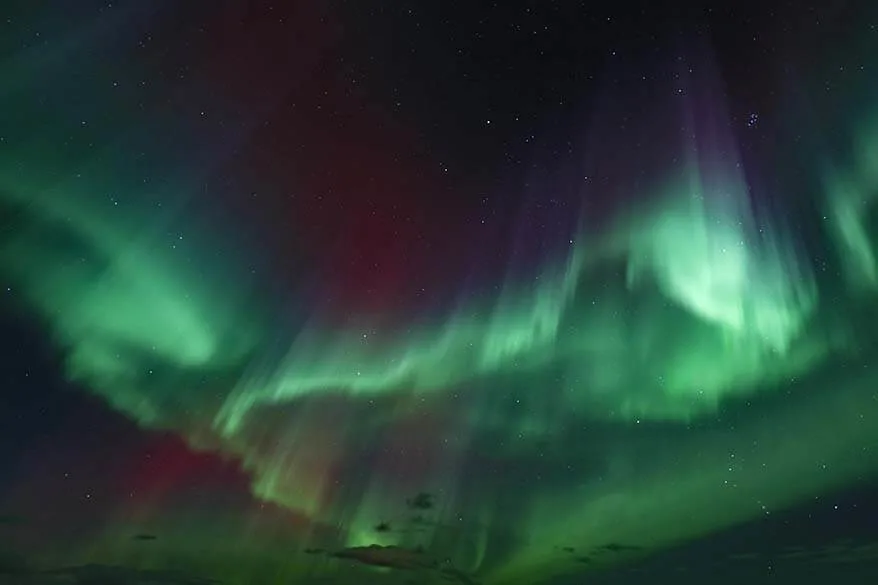
Can you see Northern Lights in Iceland in summer?
No, you cannot see the Northern Lights in Iceland in May, June, July, and the biggest part of August.
It just doesn’t get dark enough in the summer months. Summer is the season for the Midnight Sun!
The very end of August is the earliest when you can expect to see auroras in Iceland, and even then, your chances are really low.
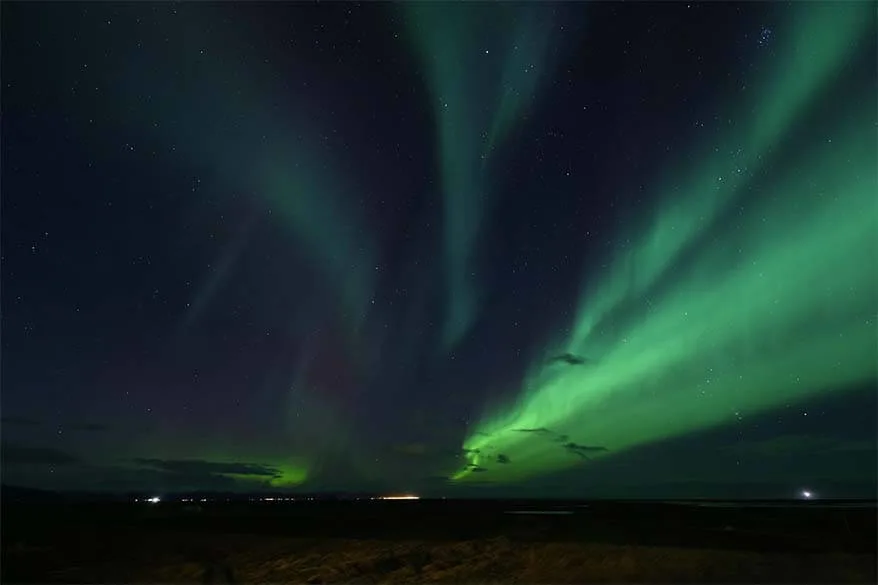
Where can you see the Northern Lights in Iceland?
You need three factors in order to see auroras: darkness, (relatively) clear skies, and aurora activity. If the conditions are right, you can see the Northern Lights anywhere in Iceland. There is no place that’s better than another and you really cannot predict this in advance!
That being said, your chances to see auroras are always higher outside the cities where there is little to no light pollution.
But as long as it’s dark, there are not too many clouds, and aurora activity is high enough, you can see the Northern Lights anywhere. If aurora activity is really high, you can even see the Northern Lights in downtown Reykjavik.
Every time someone asks which hotel to book for Northern Lights or where and when to go exactly, it makes me smile. Because, well, it’s like asking where to see a rainbow. Except that you can in fact predict the timing of some rainbows at the waterfalls, whereas you really cannot predict where and when the Northern Lights will appear.

Best hotels for Northern Lights in Iceland
As already said before, it’s really impossible to say where you should stay or which hotels are best for seeing the Northern Lights in Iceland. Auroras are a natural phenomenon, furthermore so much depends on the weather.
So if you see a list of the best hotels to stay for the Northern Lights in Iceland, take it with a grain of salt. They might be amazing hotels and have beautiful remote locations, but they cannot guarantee that you will see auroras. Nobody can.
That being said, when planning your Iceland winter trip itinerary and looking for hotels, try to pick the ones that are somewhat further away from towns. The darker it is near the hotel, the easier it will be to see auroras right there, without having to walk or take a car.
And because our readers keep on asking, below, you can find some specific hotel suggestions for the Northern Lights viewing. These are mostly hotels along the South Coast of Iceland because driving the entire Ring Road is usually not the best idea in the darkest winter months. These are just some hotels where you could stay during your winter trip and where the surroundings are usually dark enough for auroras. The rest is luck and persistence to actually go outside and wait.
Here are some nice hotels to see Northern Lights in Iceland:
- Hotel Ranga. Beautiful hotel in Hella, along the South Coast.
- Glacier View Guesthouse. A lovely small hotel in Hrifunes, between Vik and Kirkjubæjarklaustur.
- Magma Hotel. Nice hotel in Kirkjubæjarklaustur, between Vik and Jokulsarlon.
- Fosshotel Glacier Lagoon. Most beautiful hotel in the Jokulsarlon area.
- Hali Country Hotel. Great location-price-quality hotel near Jokulsarlon.
- Fosshotel Vatnajökull. Another excellent option not too far from Jokulsarlon.
- Úthlíd Cottages. A nice budget-friendly option along the Golden Circle.
- Fosshotel Hellnar. One of the best places to stay on the Snaefellsnes Peninsula.
- Lighthouse Inn. Simple hotel with a nice location in Gardur, on Reykjanes Peninsula, not too far from Keflavik airport.
Once again, note that these are just a few examples. Furthermore, we only chose accommodations that are quite easy to get to and are located in the most popular areas that you can visit in winter. There are many more good places to stay for the Northern Lights in Iceland, but seeing them is never guaranteed.
READ ALSO: Best Places to Stay in Reykjavik

Are the Northern Lights only green in the pictures?
No, auroras are not just green in the pictures and you can really see them with your own eyes. However, it is also true that weak auroras are not visible to the naked eye and only look green in the pictures.
But if you are lucky to witness a strong Northern Lights display, you will see the most phenomenal light show with all shades of green. Sometimes, auroras can also color red or purple. It’s magical!
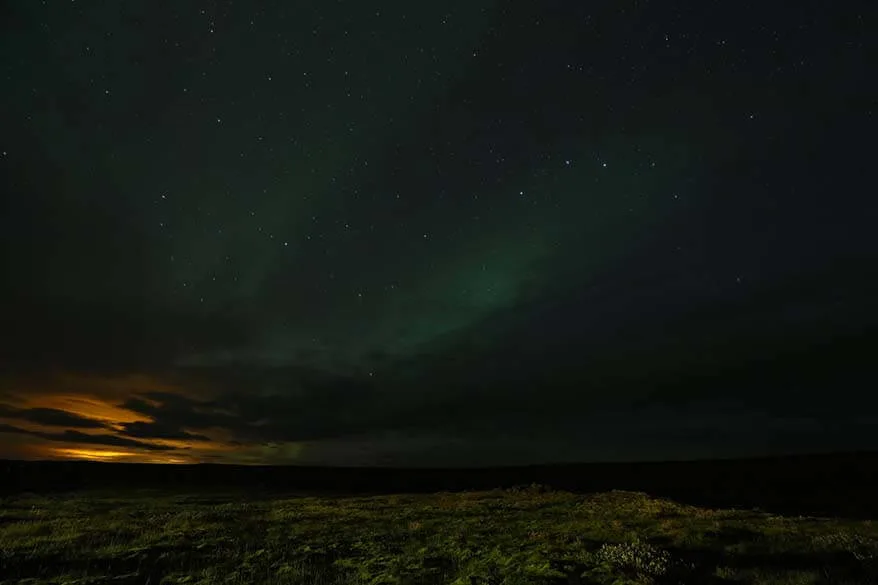
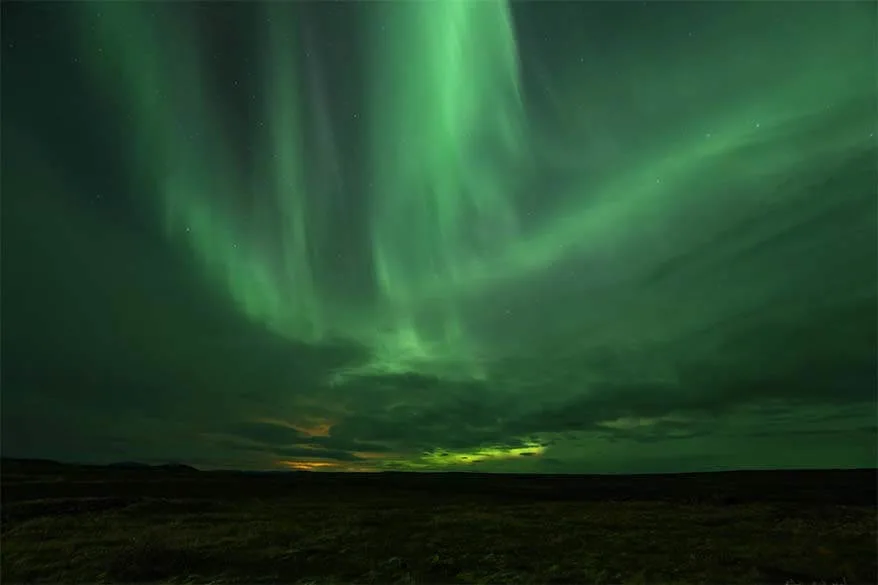
How to increase your chances of seeing Aurora in Iceland
Here are some tips on how to increase your chances of seeing auroras in Iceland:
- Travel to Iceland between September and March.
- Plan a longer trip. The longer you stay in Iceland, the more chance that the weather conditions and aurora activity will be favorable.
- Stay in hotels and accommodations outside of towns, so that you have almost no light pollution.
- Check the aurora forecast every day. We recommend the official website of the Icelandic Meteorological Office. You can also install one of the many Icelandic aurora alert apps.
- If aurora activity is at least 3-4 and you have a possibility to do so safely, drive to a place where there are no clouds that night.
- Go outside and wait! This is probably the most important tip and one where most people fail. Of course, you might get lucky and see auroras outside your hotel just after dinner. But this hardly ever happens. Most of the time, you really have to make an effort. And yes, it’s not going to be easy to stay up and spend hours outside every night. But if the aurora forecast is good and there are no clouds, you really should go outside and just wait.
- If you are staying in Reykjavik, then you should really consider taking an organized tour (more info below). Tours always go looking for the best places for that specific night; places far away from light pollution and where there are no clouds.
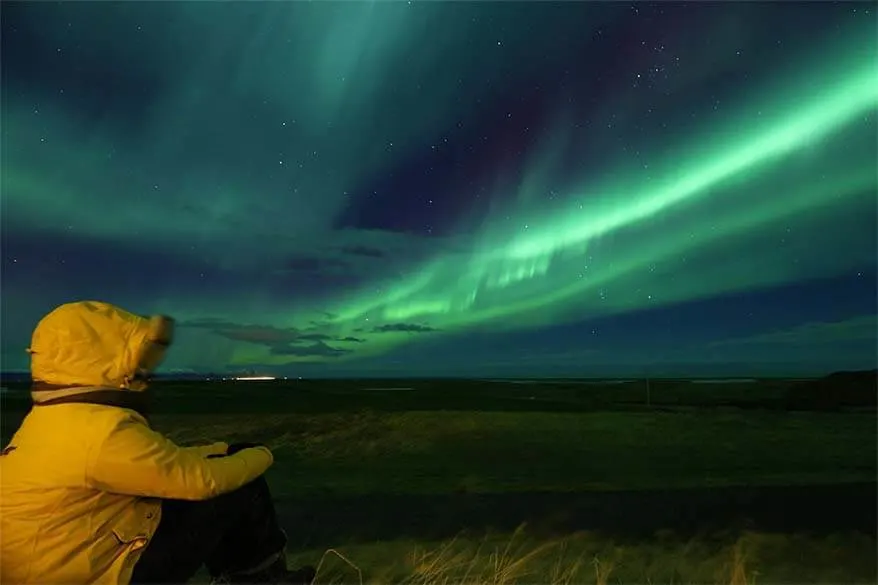
What to wear for aurora hunting in Iceland
What to wear for aurora hunting will depend a bit on the month when you visit Iceland. If you are looking for auroras in Iceland in September, you might be ok with a light jacket and a sweater. Whereas in the middle of the winter, you might need to bundle up using every single layer that you have packed (and still be cold)… In general, expect that it will be cold. Very cold.
I recommend overdressing when planning to go aurora hunting – always dress warmer than you think you’ll need. The wind is usually so strong in Iceland that it will feel much colder than the weather forecast might make you think. Also, waiting for auroras means that you sometimes stand still for long periods of time. You’ll quickly get colder than you anticipated.
To give you an idea, here is what I always wear when chasing auroras during the cold winter nights in Iceland:
- Thermal merino wool underwear (shirt and leggings from Icebreaker).
- At least two sweaters (fleece is ok as one of the layers, but wool is a must!). Once, I even wore 4 sweaters over each other and it was still cold.
- A warm wind- and waterproof winter jacket or parka.
- Very thick windproof ski pants.
- One or two pairs of wool socks.
- Very warm winter boots (I own these UGG boots. More suggestions – best winter boots for travel).
- Two pairs of gloves (thin gloves ones for photography and Goretex mittens to wear over the thin ones).
- Warm wind-proof winter hat with ear flaps (something like this isn’t exaggerated).
- A polar buff and a warm scarf or two warm buffs over each other (something like this).
READ ALSO: What to Wear and What to Pack for Iceland in Winter
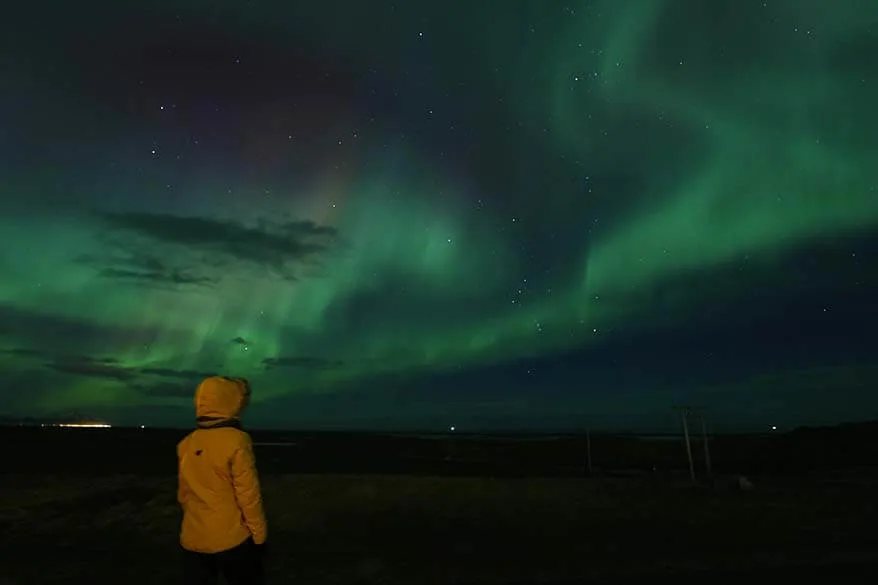
Best Iceland Northern Lights tours
There are many Northern Lights tours in Iceland and most of them run from Reykjavik. You can choose between big-bus tours, small-group tours, or private tours. In addition, you can also opt for aurora tours by boat or by super-jeep.
Here you can find the complete selection of aurora tours on GetYourGuide or on Viator. We do not recommend booking with suppliers directly, because their cancelation policy is usually not as flexible. Furthermore, if something goes wrong, it’s practically impossible to get your money back.
We recommend GetYourGuide as the very best website for any tour bookings. They have the most flexible cancelation policy and excellent customer service.
TIP: Some tours offer a free retry if you don’t get to see auroras on the first day. So it’s best to plan your tours at the beginning of the trip. That way, if you don’t get to see them and your tour offers this possibility, you can still try to reschedule for later.
Here are some of the best Northern Lights tours from Reykjavik:
- Bus tour. This has been the best-rated big bus Northern Lights tour in Iceland for several years. It also includes a free ticket to the Aurora Museum in Reykjavik. Furthermore, if you don’t see auroras on the first day, you get a free retry. This tour is much cheaper than minibus tours.
- Minibus tour. This is one of the best price-quality aurora tours from Reykjavik for those who prefer to go with a smaller group.
- Guided tour with photos. This tour includes warm drinks, blankets, and free pictures that your guides take of the Northern Lights you see that evening.
- Luxury yacht tour. This boat tour is very popular, but you should know that it can get really cold and bumpy on the water. On the other hand, you can stay inside the luxury boat and only come outside when there is something to see. It’s also very difficult to take good pictures of the Northern Lights from a moving boat, but if you are looking for an amazing experience rather than documenting it, then this is a very nice option. And if you don’t get to see auroras, at least you see some nice scenery and have a pleasant relaxing evening.
READ ALSO: Best Winter Tours in Iceland
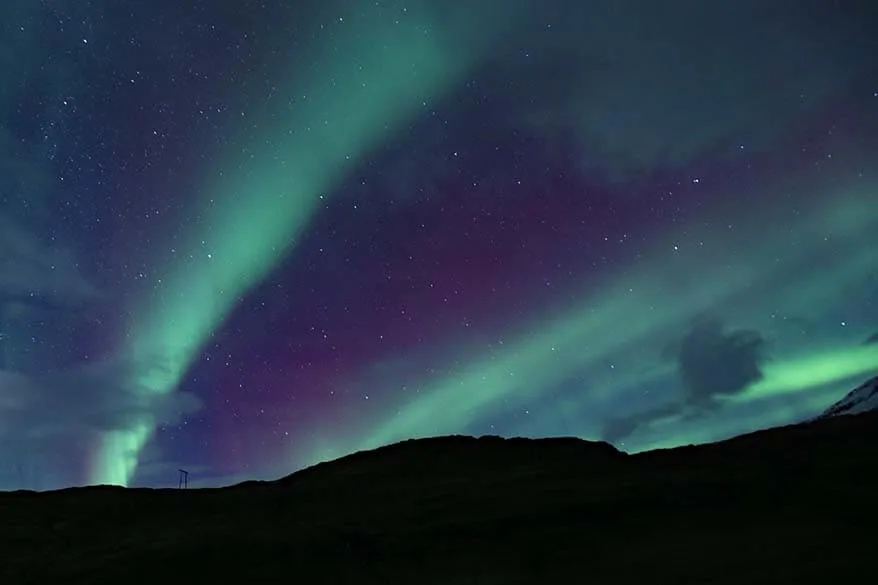
An alternative way to see Northern Lights in Iceland
If you are visiting Iceland in summer or if the weather turns out really bad and you don’t get a chance to see the Northern Lights in real life, we recommend that you pay a visit to the Perlan Museum in Reykjavik.
Among other things, you’ll be able to see the Perlan Arora Show, which is almost as good as the real thing. It’s very well done and is absolutely impressive!
I have seen auroras in Iceland and Norway multiple times, but I still found this aurora show worth a visit.
LEARN MORE: Perlan Museum in Reykjavik & Best Things to Do in Reykjavik
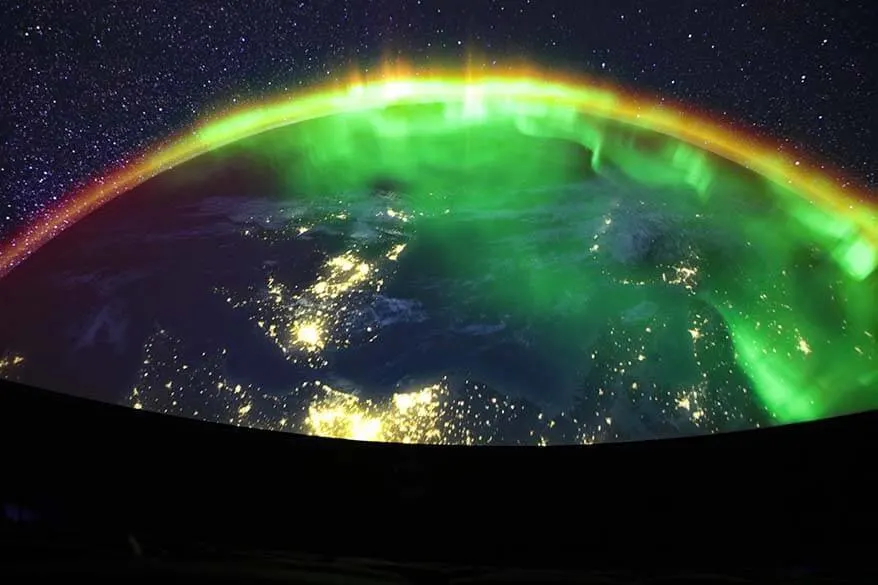
How to photograph the Northern Lights
Northern Lights photography is a bit tricky. First, it’s dark and very cold. Also, if you are lucky to see a really good display, the auroras will be moving and changing intensity all the time. And finally, most tourists only get to see auroras once or twice and don’t have much chance to practice or perfect their aurora photography skills. Often, you’ll be glad if you have one chance!
So if you want to try to take some pictures of the Northern Lights, you have to prepare in advance! And no, you don’t have to be a professional photographer, but it definitely helps to know some basic tips and camera settings to start with.
We have compiled some of our best tips and suggestions for aurora photography for beginners in a separate guide. Click on the link below to read all about it.
LEARN MORE: Northern Lights Photography Tips
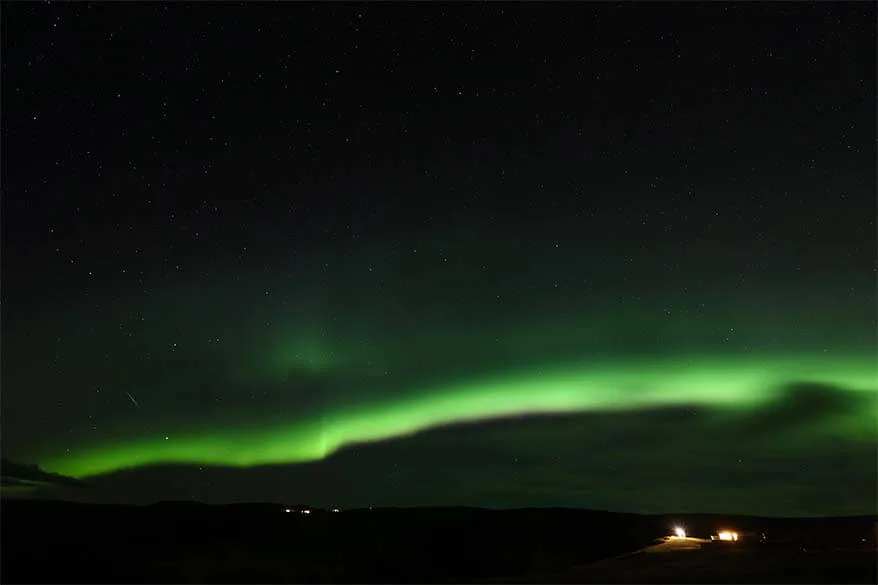
FAQ
To summarize, here are some of the most asked questions in regard to seeing auroras in Iceland:
The best months to see the Northern Lights in Iceland are between September and March. That’s when the nights are long and dark enough for viewing auroras.
Northern Lights displays can last for just a few seconds, but they can also last for several hours. I have seen aurora displays that lasted no longer than 5 seconds, but I have also seen magnificent aurora shows that lasted several hours. Sometimes, they stop but then reappear again and the show can go on for hours.
Yes, it’s possible to see Northern Lights in Reykjavik. If the aurora display is very strong, you can sometimes see it despite the lights of the city (I have even seen them from my hotel window in Reykjavik). That being said, your chances are always higher in the darker places, a bit outside the city center. The area around Grótta Island Lighthouse is one of the best places to see auroras in Reykjavik.
Yes, you can see the Northern Lights even if there is a full moon. If the auroras are weak, then the strong moonlight might make it more difficult to see them. But if auroras are strong, it’s definitely possible. Once, I saw a magnificent aurora show that lasted more than 3 hours under the full moon.
If the conditions are right, you can see the Northern Lights EVERYWHERE in Iceland. There is not one place or region of Iceland that’s better for viewing auroras than another.
If you are visiting Iceland between September and October, there is always a good chance of seeing the Northern Lights. However, auroras are a natural phenomenon and you need clear skies in order to see them, so you really cannot plan or predict it in advance.
While Iceland is a very good place to see the Northern Lights, it’s not the very best place in the world. Because of its location directly on the Aurora Ring, the Tromsø area in Norway is considered one of the very best places to see the Northern Lights in the world. There, you can see auroras even if the activity is very low and the chances for clear skies are higher. More information – Northern Lights in Tromso.
More tips for your winter trip to Iceland:
- Useful info: Tips for Visiting Iceland in Winter
- Bucket list: Best Things to Do in Iceland in Winter
- Good to know: Iceland Travel Tips
- Must-read: Driving in Iceland in Winter
- Packing: What to Wear in Iceland in Winter
- Itinerary: The Best Iceland Winter Itinerary & 1 Day in Reykjavik
- Where to stay: Where to Stay in Iceland & Where to Stay in Reykjavik
- Airport transfers: How to Get to Reykjavik from Keflavik Airport
- Budget: How Expensive is Iceland (& How to Save Money)
- Tours: Best Winter Tours from Reykjavik
READ ALSO: Best Places to See on the South Coast of Iceland
If you found this post helpful, don’t forget to bookmark it and share it with your friends. Are you on Pinterest? Pin this image!
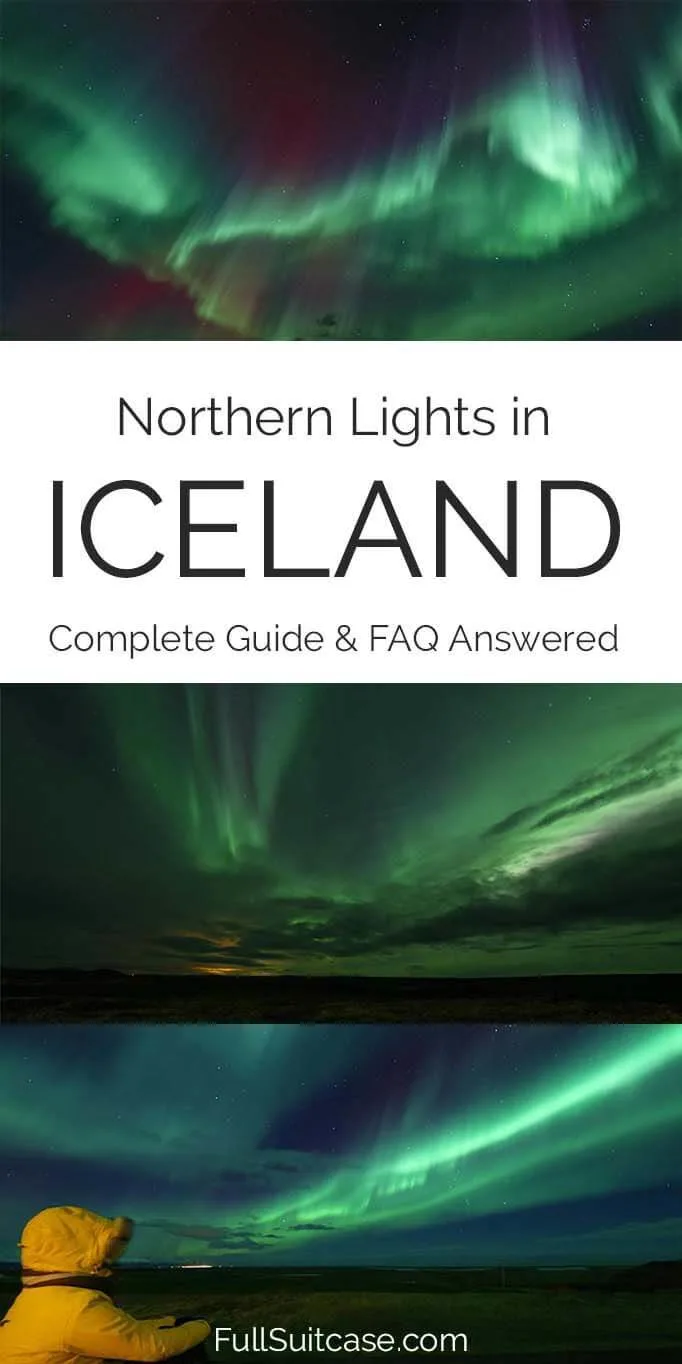

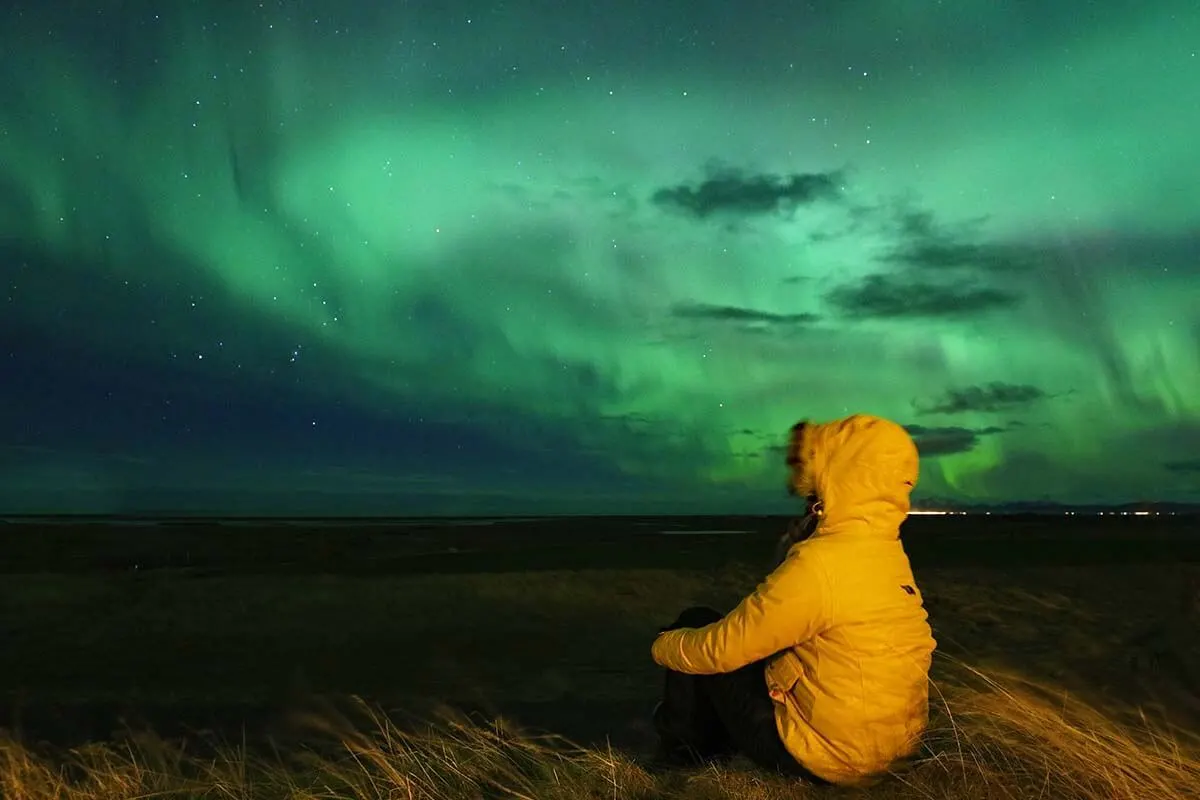
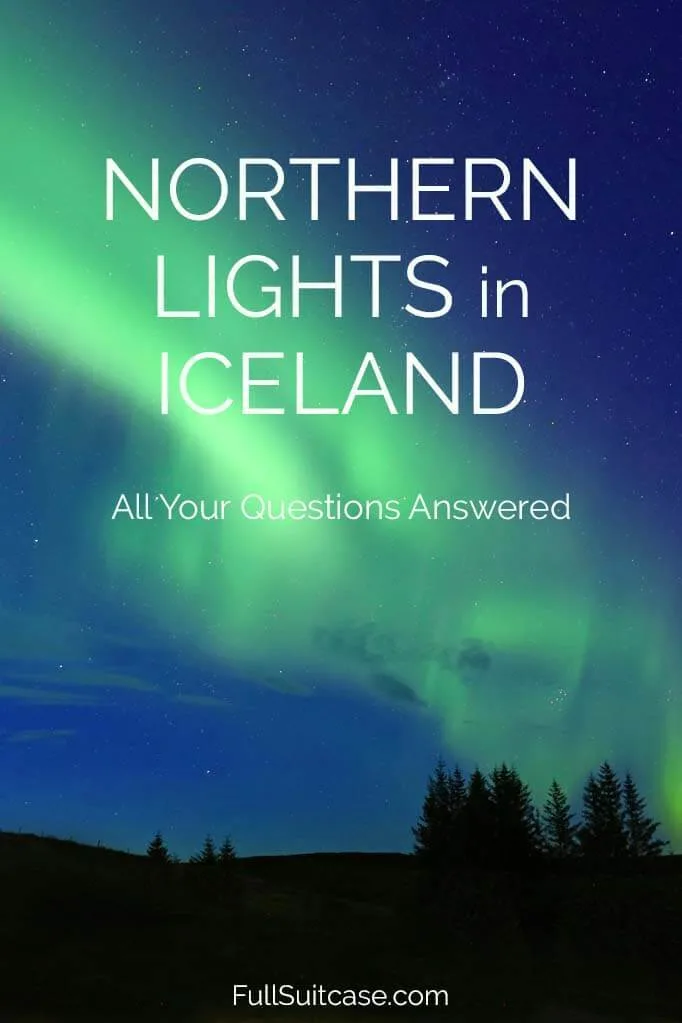
Lindsey Wilson-Willis
Monday 6th of November 2023
Hi there. Thanks for the article. Really helpful. We are in Reykjavik tonight only. Where will be best to try and see the NLs. Thank you,
Lindsey Wilson-Willis
Monday 6th of November 2023
@Jurga, we have a car…. Are you able to recommend a ‘good chance’ destination? Thanks again. Lindsey
Jurga
Monday 6th of November 2023
Hi Lindsey, I see on the aurora forecast map that cloud coverage doesn't look great for Reykjavik tonight, but there are some openings nearby, so maybe you have a chance. Going on a tour (by bus or boat) would increase your chances. But if you rather stay in the city, then it's best to go to the darkest waterfront areas. For example, to Grótta Island Lighthouse, which is located a bit outside of the center in the area that has less light pollution. Good luck!
Kelly
Monday 26th of December 2022
Great article! However, our travel plans put us to arrive April 18th and it seems most of the tours stop April 15th...can you recommend a good way to try and see them without a tour? Would it just be to rent a car and drive somewhere?
Jurga
Tuesday 27th of December 2022
Hi Kelly, most tours stop because it becomes too light at that time of the year and the chances of seeing auroras are really low. Even April 15 is probably already stretched. That being said, you can always see how the conditions are, and if it’s dark enough and there is a strong aurora activity, just go outside and wait. But it has to be really dark so it helps if you’re not in the middle of the city. You can download some aurora apps and keep an eye on what they predict, but don’t count on it at that time of the year.
Angela Hunter
Friday 17th of December 2021
Beautiful shots of the light show, thank you so much for sharing them. I didn’t know that some of the light is only seen for a few seconds.
I can’t wait until the airline restrictions are lifted. I would be there in a minute!
Jurga
Monday 20th of December 2021
Hi Angela, yes, auroras are quite unpredictable and you never really know what 'show' you're going to get. Hope you can experience it one day!
Sally
Tuesday 24th of August 2021
I teach - so very limited in when I can travel to Iceland. If I am traveling in early August, and go pretty North (like porshofn or Raudanes Point), and ensure that I am at that point during the new moon. What are the chances of seeing Northern Lights?
Sally
Wednesday 25th of August 2021
@Jurga, thank you so much for your answer! I think this will then just be a hiking/waterfalls hike.
I teach college so not as many days off and my spouse is so low on the totem pole at their job that taking days off around holidays os not happening. So we will have to plan something else for northern lights. Maybe Norway :-)
Jurga
Wednesday 25th of August 2021
Hi Sally, unfortunately, your chances of seeing the Northern Lights anywhere in early August are pretty much 0. It just doesn't get dark enough yet up North. The earliest you could hope to see them is from approximately the last week of August. Also, in summer, it's actually lighter the further north you go. So going to the northernmost point in Iceland in early August would just give you even more daylight than staying in Reykjavik (not that any of that matters much because it simply doesn't get dark at night at that time of the year). Having said all this, we travel with kids and can also only travel during school holidays. Still, we have quite a few holidays that fall between September and March (potentially early April), so if you have any vacations during that time of the year, it would be a much better chance for auroras. On the other hand, Iceland is also amazing in early August and well worth a trip even though you won't see auroras (but can witness the midnight sun). It's just a totally different experience traveling there in summer or in winter.